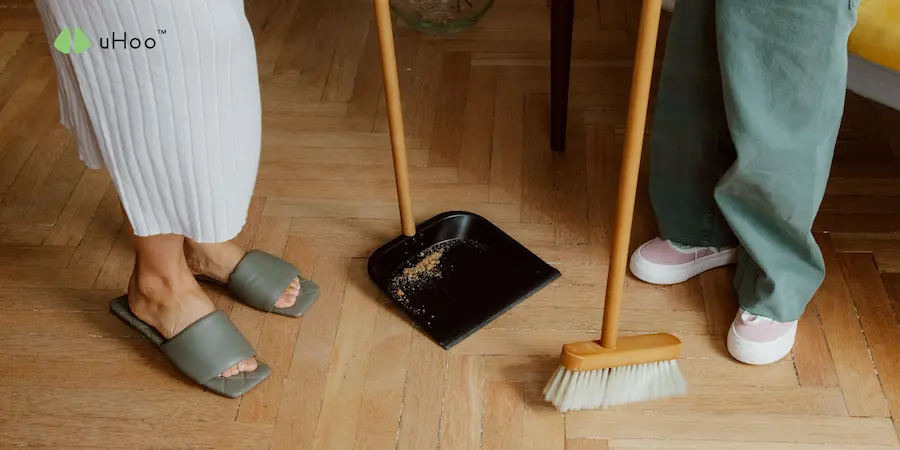We often think of hard floors – hardwood, tile, laminate – as inherently cleaner than carpets. After all, you can see the crumbs and the obvious dirt, right? But beneath that seemingly clean surface lies a world of “invisible dust” – microscopic particles of allergens, pet dander, pollen, and other irritants that can significantly impact your indoor air quality. Simply sweeping or a quick mop might not be enough to truly eradicate this hidden menace.
Here’s how to go beyond the visible and achieve genuinely clean hard floors.
Step 1: The Pre-Clean Power Sweep (or Vacuum!)
Before you even think about wet cleaning, the crucial first step is to remove all loose debris. While a broom might seem sufficient, a vacuum cleaner with a hard floor attachment is often more effective at capturing fine dust and allergens without scattering them. Look for attachments with soft bristles or felt pads to avoid scratching your floors. Pay close attention to edges, corners, and under furniture where dust tends to accumulate.
Step 2: The Microfiber Marvel: Embrace the Right Mop
Ditch the traditional string mop that can push dirty water around. Microfiber mops are the superheroes of hard floor cleaning. Their unique fibers trap and lift dirt and dust effectively. Choose a flat microfiber mop with washable pads for an eco-friendly and efficient cleaning experience.
Step 3: The Gentle Solution: Less is Often More
When it comes to cleaning solutions for hard floors, less is often more. Harsh chemicals can damage finishes and leave behind residues that attract more dust. Opt for pH-neutral cleaners specifically designed for your floor type. For a natural approach, a diluted solution of white vinegar and water (about ¼ cup vinegar per gallon of water) can be surprisingly effective for general cleaning and deodorizing. Avoid using excessive water, as it can seep into seams and damage some flooring materials.
Step 4: The Two-Bucket Tango: Keeping it Clean
Here’s a pro tip for truly clean floors: use two buckets. One bucket contains your cleaning solution, and the other is for rinsing your mop pad. This prevents you from spreading dirty water back onto your floors, ensuring you’re actually removing grime rather than just moving it around.
Step 5: The Systematic Mopping Method
Work in sections, moving the mop in smooth, overlapping strokes. Rinse your mop pad frequently in the clean water bucket and wring out excess moisture before continuing. This prevents the buildup of dirt on your mop and ensures a more effective clean.
Step 6: The Corner Crusader: Don’t Neglect the Edges
Dust and debris love to accumulate along baseboards and in corners. Use a crevice tool attachment on your vacuum or a handheld brush to tackle these often-overlooked areas before you mop.
Step 7: The Drying Directive: Prevent Streaks and Residue
Allow your hard floors to air dry completely. If you want to avoid streaks, you can gently dry the floor with a clean, dry microfiber cloth after mopping.
Step 8: The Rug Routine: Don’t Forget Area Rugs
Area rugs on hard floors can trap a significant amount of dust and allergens. Vacuum them regularly, just as you would wall-to-wall carpets. Consider shaking them out outdoors periodically for a more thorough clean.
Step 9: The Preventative Protocol: Mats and Habits
Just like with carpets, using doormats at all entrances is crucial for preventing dirt and dust from being tracked onto your hard floors. Encourage everyone to wipe their shoes. Regularly sweeping or vacuuming high-traffic areas can also prevent the buildup of invisible dust.
Step 10: The Smart Air Sentinel: Investing in a uHoo
While these cleaning techniques address the dust on your hard floors, a uHoo air quality monitor can provide an invaluable layer of insight into the overall air quality of your home. uHoo tracks particulate matter (PM2.5 and PM10), which includes the very fine “invisible dust” particles that can be harmful to your health.
By monitoring these levels, uHoo can alert you when the amount of dust in the air is elevated, even if your floors appear clean. This can prompt you to adjust your cleaning routine, improve ventilation, or consider using an air purifier to ensure a truly clean and healthy indoor environment for you and your family. It’s about going beyond what you can see to address the invisible dust that truly matters.



